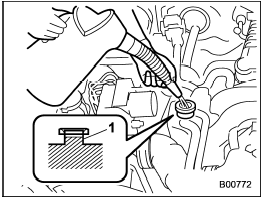 Subaru Forester: Changing the coolant
Subaru Forester: Changing the coolant

Never attempt to remove the radiator cap until the engine has been shut off and has cooled down completely. Since the coolant is under pressure, you may suffer serious burns from a spray of boiling hot coolant when the cap is removed.
Always add genuine SUBARU cooling system conditioner whenever the coolant is replaced.
Change the engine coolant and add genuine SUBARU cooling system conditioner using the following procedures according to the maintenance schedule.
1. Remove the under cover.

2. Place a proper container under the drain plug and loosen the drain plug.
3. Loosen the radiator cap to drain the coolant from the radiator. Then drain the coolant from the reserve tank. Tighten the drain plug securely.
NOTE (turbo models only) The cap (without tabs) on top of the radiator does not need to be removed.
To add coolant, remove the cap (with tabs) on the coolant tank on top of the engine.
4. Install the under cover.

Non-turbo models
1) Fill up to this level

Turbo models
1) Fill up to this level
5. Slowly pour the coolant and fill up to just below the filler neck, allowing enough room to add genuine SUBARU cooling system conditioner in the radiator. Add genuine SUBARU cooling system conditioner until the coolant level reaches the filler neck. Do not pour the coolant too quickly, as this may lead to insufficient air bleeding and trapped air in the system.
NOTE
For guidelines on coolant quantity
(including the coolant in resorvoir
tank), refer to “Engine coolant”.

1) “FULL” level mark
2) “LOW” level mark

- Be careful not to spill engine coolant when adding it. If coolant touches the exhaust pipe, it may cause a bad smell, smoke, and/or a fire. If engine coolant gets on the exhaust pipe, be sure to wipe it off.
- Do not splash the engine coolant over painted parts. The alcohol contained in the engine coolant may damage the paint surface.
6. Pour the coolant and fill to the reservoir tank’s “FULL” level mark.

7. Put the radiator cap back on and tighten firmly. At this time, make sure that the rubber gasket in the radiator cap is correctly in place.
8. Start and race the engine at 2,000 to 3,000 rpm for 5 to 6 times within 40 seconds.
9. Stop the engine and wait until the coolant cools down (122 to 1408F [50 to 608C]). If there is any loss of coolant, add coolant to the radiator’s filler neck and to the reserve tank’s “FULL” level.
10. Put the radiator cap and reservoir cap back on and tighten firmly.
 Checking the coolant level
Checking the coolant level
Checking the coolant level
1) “FULL” level mark
2) “LOW” level mark
Check the coolant level at each fuel stop.
1. Check the coolant level on the outside
of the reservoir while the eng ...
 Air cleaner element
Air cleaner element
Do not operate the engine with the
air cleaner element removed. The air
cleaner element not only filters
intake air but also stops flames if
the engine backfires. If the air
cleaner elem ...
See also:
NISSAN Vehicle Immobilizer System keys
NISSAN Vehicle Immobilizer System keys
1. Master key (2)
2. Key number plate (1)
Your vehicle can only be driven with the master
keys which are registered to the NISSAN
Vehicle Immobilizer S ...
Continued
This symbol
can be found at the lower right
corner of an odd-numbered (right-hand) page
to indicate that the current topic is continued
on the following page. ...
Glove compartment lighting
The glove compartment lighting switches on/
off automatically when the lid is opened/
closed. ...
